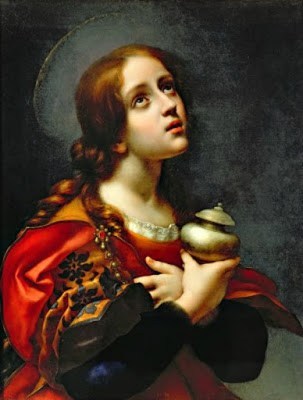Saint Mary, whom Jesus converted, and who witnessed His last
moments in company with Mary, His Mother, and St. John, the beloved
disciple, was called Magdalen from the town of Magdala in Galilee. At
least St. Clement of Alexandria and others identify the penitent woman
who washed Jesus feet with her tears with Mary Magdalen.
She was by descent a Galilean, and followed Jesus with other devout
women. Some also suppose that she was the same Mary who was the
sister of Martha and Lazarus. After His Resurrection, Jesus appeared
first to Mary Magdalen and then to His Apostles. It is an ancient
tradition in Provence, France, that St. Mary Magdalen, or Mary the
sister of Lazarus, together with Lazarus, Martha and some other
disciples of Our Lord, being expelled by the Jews, put to sea and landed
at Marseilles; and that St. Lazarus became the first Bishop of that See.
Lives of the Saints, pgs. 279-280
“Three saints” said our Lord to St. Bridget of Sweden, “have been
more pleasing to me than all other: Mary my mother, John the Baptist,
and Mary Magdalen.” The Fathers tell us that Magdalen is a type of the
Gentile Church, called from the depth of sin to perfect holiness; and
indeed, better than any other, she personifies both the wanderings and
the love of the human race, espoused by the Word of God…Albert the
Great assures us that, in the world of grace as well as in the material
creation, God has made two great lights—to wit, two Mary’s, the
Mother of our Lord and the sister of Lazarus: the greater, which is the
blessed Virgin to rule the day of innocence; the lesser, which is Mary
the penitent beneath the feet of that glorious Virgin, to rule the night by
enlightening repentant sinners. As the moon by its phases points out the
feast days on earth, so Magdalen in heaven gives the signal of joy to the
angels of God over one sinner doing penance. Does she not also share
with the Immaculate One the name of Mary, Star of the sea, as the
Churches of Gaul sang in the Middle Ages, recalling how, though one
was a Queen and the other a handmaid, both were causes of joy to the
Church: the one being the gate of salvation, the other the messenger of
the Resurrection? The Liturgical Year, XIII, Book IV, pgs. 160 & 165
